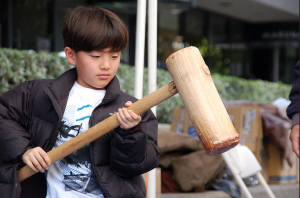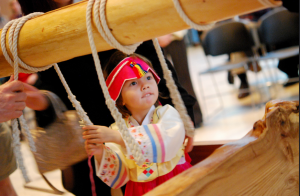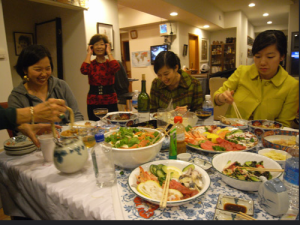The biggest holiday of the year is upon us. For people in Japan, New Year’s is a time for family and food. Since the mid 1800s, Japan has recognized January first as New Year’s Day. Oshogatsu, or Japanese New Year’s, is the most anticipated holiday where families gather to eat celebratory foods called Osechi. “I feel like in America, the big eating day is Thanksgiving, but let’s be honest, every good JA (Japanese American) knows the real eating holiday is on New Year’s”, says Stephanie Nitahara, a yonsei (fourth generation Japanese American) from Chicago (photo by Eric Nakamura).
Each dish is symbolic. For example prawns represent longevity; black soybeans for good health; and separated boiled egg pressed into a mold somewhat resembling a cake roll, symbolizes wealth and good fortune. Some JAs, like Kimberly Kruse, continue to spend New Year’s Eve, and the early hours of New Year’s Day, cooking after eating a quick meal of soba noodles. The dish is easy to prepare when time is short, and the noodles are long, good luck for a long and healthy life. For most, eating the noodles after midnight is bad luck.
Japanese Americans have adapted the holiday to retain some of the old traditions while adding in newer ones. According to Michael Fujinaka, some customs have unknown origins, like having whiskey rubbed on his forehead by JA elders as a child. Others include serving American style dishes alongside the Japanese. For Kelly Honda, those dishes were rice pilaf and miniature hot dogs wrapped in crescent rolls sharing a table with sashimi, karaage, and spam musubi.
In a time conscious world, most people forgo spending days preparing traditional Osechi, and buy ready made meals from grocery stores and restaurants. Osechi can be found in many Japanese American community centers, Buddhist temples, and churches. Others go on what is essentially an Osechi food crawl visiting numerous houses of relatives and friends, something my mom did with her family in Northern California in the 1960s and 1970s.
Mochitsuki, or mochi making, is the art of pounding rice to make sticky, delicious rice cakes. Though most mochi are made by machine, many communities and families continue to pound the rice by hand with large wooden mallets in giant stone bowls. For most, it’s one of the few times during the year when fresh mochi is available. Thanks to the rising popularity of mochi ice cream and manju (mochi filled with sweet bean paste), the chewy and versatile food is going mainstream. For those in areas where mochitsuki isn’t easily accessible, a quick trip to Trader Joe’s can satiate most cravings for mochi where Mikawaya mochi ice cream is available in a variety of flavors (photo by Derral Chen).
cakes. Though most mochi are made by machine, many communities and families continue to pound the rice by hand with large wooden mallets in giant stone bowls. For most, it’s one of the few times during the year when fresh mochi is available. Thanks to the rising popularity of mochi ice cream and manju (mochi filled with sweet bean paste), the chewy and versatile food is going mainstream. For those in areas where mochitsuki isn’t easily accessible, a quick trip to Trader Joe’s can satiate most cravings for mochi where Mikawaya mochi ice cream is available in a variety of flavors (photo by Derral Chen).
Though the main focus of New Year’s appears to be food, areas with large Japanese American populations commemorate the new year with festivals and parties. Complete with kite decorating for children, taiko drums, traditional Japanese music, and spiritual services, it’s one of several events throughout the year where JAs congregate and celebrate a common heritage.
 At the stroke of midnight, Buddhist temples in Japan and around the world ring bells 108 times to absolve the sins of the year before. Many U.S. temples alter the timing a little bit, usually to accommodate other festivities like in San Diego where the bell ringing takes place before the annual fireworks display (photo by Asian Art Museum).
At the stroke of midnight, Buddhist temples in Japan and around the world ring bells 108 times to absolve the sins of the year before. Many U.S. temples alter the timing a little bit, usually to accommodate other festivities like in San Diego where the bell ringing takes place before the annual fireworks display (photo by Asian Art Museum).
Though the New Year’s celebrations in Japanese American communities have changed throughout the years and in many ways, differ largely from one another, the basic premise remains. Start each year anew with family and delectable foods while honoring our culture’s rich traditions. Despite the hardships of the year to come, the biggest hardship of each January first, is figuring out how to lose the pounds we’ve inevitably put on during our extended holiday season.


The biggest holiday of the year for Japanese Americans is New Year’s: Excellent!